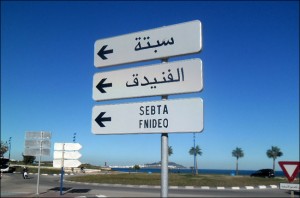Analysis and photos by Imran Binoual in Martil
for Magharebia
Magharebia heads to northern Morocco to investigate the surprise exodus of young jihadi fighters to Syria and Iraq.
As jihadist recruiters stake out northern Morocco and the kingdom witnesses an unprecedented spike in security threats, Magharebia visits Fnideq to see why and how young people leave home to join the Islamic State terror organisation.
Border towns vulnerable
“The Fnideq area is known for the participation in the ISIS jihad of its youth, specifically those from the Ras Lota neighbourhood,” says Mustafa al-Chaer, president of local NGO “Ras Lota for Communication”.
There are two kinds of recruits from the region, he explains.
“The first category consists of youth clinging to the jihadi idea. The second was influenced through YouTube or the internet in general,” he tells Magharebia.
He adds, “This category of youth surprised us. We thought we were quite far away from this kind of thinking, until their families were informed that their children had travelled to Syria… These were ordinary young people, but they had a kind of weakness, meaning that this way of thought controlled them, attracted and lured them.”
“I personally uncovered some of the recruits and confronted them, because they had been influenced by brainwashing,” he says. They include “youth whose parents are wealthy” and others “who belong to poor classes”, al-Chaer adds.
The location of the region also plays a major role in its vulnerability.
“Fnideq is a border area,” he notes. “These areas have become more vulnerable to the migration of youth. As it is said, most problems are solved at the centre, meaning major cities such as Rabat and Casablanca, while small cities are ignored or marginalised.”
And youth of marginal cities, he adds, “either become deviant and deal drugs, or turn to religious extremism”.
But according to Al-Chaer, there has been a decline in Daesh appeal, especially since there’s always news about the death of yet another young man from the region.
Parents have also begun to tighten control over their children, and security authorities are anticipating events instead of reacting.
Jihadi recruiters target poor
Fnideq community activist Mohamed Youness says that young people here are more vulnerable to extremist recruiters than those living in other Moroccan cities.
“Among the reasons I noticed – as a son of the region – are the marginalisation witnessed by the city of Fnideq; the failure of the political parties or civil society to educate these young people, in order to integrate them in the city’s policies; and their exclusion by the state,” he tells Magharebia.
And then there’s the proximity to Ceuta.
“Spanish security arrested the famous Ceuta cell, which had a role in this case, recruiting fighters for Syria,” Youness notes.
Young people were brainwashed into leaving, yet when they arrived in the conflict zone, they discovered the truth and ran away.
Now, many want to return to their homeland but fear they will be detained by Moroccan security authorities and prosecuted on terrorism charges.
As local high school teacher Zakaria, tells Magharebia, “Moroccan fighters who join jihadi cells find themselves between two options, the sweetest of which is bitter.”
“It is difficult to step back and return to the homeland for fear that they will get imprisoned in their country, and bitter to face death in a bloody battle,” the teacher adds.
The curse of ISIS on Martil
The city of Martil, part of the province of M’diq – Fnideq, is home to a number of young people who have joined Daesh, and yet few residents are willing to talk about it.
One man confirms that terrorist cells in Martil are actively trying to youth to join the Islamic State.
“These cells have targeted recently a group of inner city youth to join ISIS, including three young men from Chbar, and the rest from marginal neighbourhoods like Diza and Zawiya,” he tells Magharebia.
“They say it will provide them with a good living in Syria,” he says. “Most of these young people were lured by the cell in exchange for fictional funds.”
Today, as we visit the town, security forces are looking for the parties behind pro-ISIS graffiti that appeared in Martil’s poor Ahriq neighbourhood.
They have already tightened surveillance of train and taxi stations.
By monitoring all suspicious activity, they aim to crack down on the recruitment and despatch of young Moroccans to ISIS.








